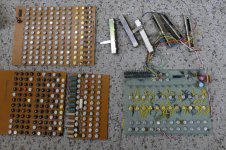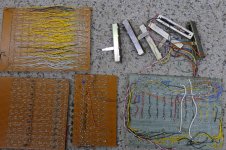Target shooting is so much more pleasant without the noise.
That's why I have a slingshot hanging on my wall!
Almost pulled the trigger on a vacuum desoldering station but decided to wait.
I bought this one, after tiredness of buying tips for my Hakko 808!
And surprise, it works great!
120V 40W Electric Desoldering Iron Vacuum Solder Sucker w/ 1.5mm 2mm tips & file | eBay
Last edited:
Wow, the Russians put a lot of dogs in space back in the day! I remember reading about Laika, but I had no idea...
Soviet Space Dogs (Wikipedia)
Soviet Space Dogs (Wikipedia)
Could this be a song to them?
SPACE DOG
I must admit that I have two slightly provoking Tee-shirts on the socialist/communist theme. And both have been subject to protests in the town council meetings.
As I like to provoke, I think that maybe this Tee will get some attention, but it is rather un-political, I can move safely.
Here are the other two in my collection:


SPACE DOG
I must admit that I have two slightly provoking Tee-shirts on the socialist/communist theme. And both have been subject to protests in the town council meetings.
As I like to provoke, I think that maybe this Tee will get some attention, but it is rather un-political, I can move safely.
Here are the other two in my collection:


Last edited:
I haven't the first clue what Tori is singing about, although I'm guessing it's probably not Laika et al. Lyrics like hers just make me feel...thick as a brick. On the other hand, great snare drum sound on that tune. Has an almost silky texture to it. Nice.
That explains a lot......You can see that I need a Japanese diet pretty quickly, I'm basically living off chips and thickshakes.
Healthy gut microbiome, healthy body, healthy mind.
Google is your friend.
Dan.
Talking of chips and Russian spacedogs ...
Marillion - Marillion.com
Marillion - Radiation
Marillion - This Strange Engine
Moody Blues - On The Threshold Of A Dream (iNot their best album, far from it, but M.B. is a great group and I needed one more CD to get a USD12 discount. Threshold as just $8)
Marillion - Marillion.com
Marillion - Radiation
Marillion - This Strange Engine
Moody Blues - On The Threshold Of A Dream (iNot their best album, far from it, but M.B. is a great group and I needed one more CD to get a USD12 discount. Threshold as just $8)
I ordered a 1.5A charger for a 12V lead/acid battery.
It arrived this morning.
Tiny and must be some switching topology. VERY cheap, let's hope it is reliable.
£2.98 delivered from china via Ebay/UK
12V Smart Compact Battery Charger Tender Maintainer For ATV Car Truck Motorcycle | eBay
It arrived this morning.
Tiny and must be some switching topology. VERY cheap, let's hope it is reliable.
£2.98 delivered from china via Ebay/UK
12V Smart Compact Battery Charger Tender Maintainer For ATV Car Truck Motorcycle | eBay
On The Threshold Of A Dream (iNot their best album, far from it
It's one of my favorites. Right up there with In Search Of The Lost Chord and To Our Children's, Children's Children
Yesterday's purchase.......750 reed relays, cheap surplus. It will be a crude attempt to add MIDI to the Hammond organ purchased a few days ago.
Last edited:
You're my hero!!!!Yesterday's purchase.......750 reed relays, cheap surplus. It will be a crude attempt to add MIDI to the Hammond organ purchased a few days ago.
Bought some time ago and goot it delivered today - a battery adapter for my EOS M3 camera. Replaces the batteey with an adapter powered by a wallwart.
And ordered som 330pF caps to my SymAsym amp, a driver for VFD-displays (thats two displays as D stands for Display - my bad), some CMOS-555 for a simple sequencer and some IR-LEDs for my scanner project - firing off my camera remotely.
Yesterday's purchase.......750 reed relays, cheap surplus. It will be a crude attempt to add MIDI to the Hammond organ purchased a few days ago.
Wow.
Respect.
IMHO, the Moodys were one of the grossly underappreciated groups of their day, and paved the way for that special blend of rich orchestral, family friendly psychedelic that appealed to those of us mid 1960's pubescents not quite ready for the hard stuff. Gateway drug, I guess?
Dan - leaky gut is one of those "killing us softly" syndromes that is poorly/under-diagnosed - perhaps as it's not a quick "take this pill" fix ?
Dan - leaky gut is one of those "killing us softly" syndromes that is poorly/under-diagnosed - perhaps as it's not a quick "take this pill" fix ?
Last edited:
...Yesterday's purchase.......750 reed relays, cheap surplus. It will be a crude attempt to add MIDI to the Hammond organ purchased a few days ago.
Damn! If you're talking MIDI into a Hammond, that would truly be some pioneering work. One caveat: You'd be bypassing one of the components of the classic Hammond sound, which is the "key click" noise of the original key switch contacts. But the relays are likely to have a similar sound, and perhaps with a bit of very brief, random latency programmed in between the individual harmonic (drawbar) contacts of each key, to "thicken" it up a little...

750 reed relays......You're my hero!!!!.....Wow. Respect.
Let's see 750 relays, 4 pins on each.....driver circuitry....microprocessor + code.....possible?
Rewind back to 1970. LP concert, wow....I gotta git me one of those. Yeah, synthesizer / Hammond dreams, 17 year old kid finances.....OK, I'll build it.
I had learned the fine art of making tube amps out of trash. Literally, I got parts from dead radios, HiFi and TV sets at the local trash dump. My friends and I had learned which electronics plants had good stuff in their dumpsters, and Coulter Diagnostics (still around) had provided me with tons of scrap boards containing IC chips and other goodies.
The recording studio I hung around had a Hammond B3, and I loved it's sound, and the variations you could get with the drawbars, so I set out to build a organ / synth with drawbars.
I started building this monster digital music synthesizer in mid 1971 and by mid 1972, I had it making sound. It was built in the cabinet of a Hammond transistor organ that I had traded something for (don't remember what but likely a stereo or guitar amp). In December on 72 I landed a job at Motorola 40 miles away, so the synth would sit at my parents house for several months until they were going to trash it. I ripped out the perf board electronics that I had made, and still have most of them 45 years later. Some day I'm going to power this stuff up to see what happens.
These boards are mostly digital, built with RTL logic from the 1960's. Each round metal chip has 8 pins and contains a single gate or flip flop.
The large brown board with all the metal chips is the tone generator. It generates 5 octaves of notes (limited by the maximum chip speed of less than 1 MHz) from a single clock. The brown board with mostly black chips (logic gates) is the keyboard interface. The green board prvides the harmonics for the drawbars (slide pots), again limited by clock speed.
Now, about 350 chips with 8 pins each.....B+, ground and signal wiring........Now you know why I can't convince myself to toss this stuff.
Attachments
Last edited:
- Home
- Member Areas
- The Lounge
- And what did we buy today?


